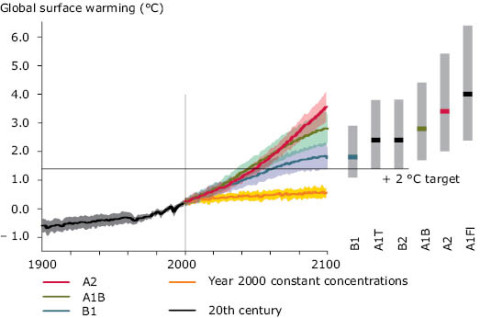Climate Talks: 2° Target
Press release by the Potsdam Institute for Climate Impact Research
Success of climate talks vital for 2°C target
Achieving a global climate agreement soon could be crucial for the objective to keep global mean temperature rise below 2 degrees Celsius. The challenges of meeting the long-term target will otherwise increase drastically both in terms of the required emissions reductions and economic impacts. This is shown by the first comprehensive multi-model-based assessment of so-called Durban Platform scenarios, conducted by a team of international scientists led by the Potsdam Institute for Climate Impact Research (PIK) and the Fondazione Eni Enrico Mattei (FEEM) in Italy. The Durban Platform is the current negotiation track at the Warsaw climate talks that aims to reach a global climate agreement by 2015 to come into effect in 2020
“The negotiations in Warsaw represent an important step in the negotiation process towards a climate agreement by 2015,” lead author Elmar Kriegler from PIK says. “While there are legitimate doubts about whether the Durban Platform negotiations can deliver on their promise, our analysis shows the importance of meaningful reductions in global emissions by 2020 to keep the 2 degree target within reach.” The later emissions get cut, the greater the necessary reduction rates to avoid more than 2 degrees warming, and hence the greater the impact on energy prices and economic growth.
“Even a delay of just 10 years of a climate agreement coming into effect would raise the economic challenges substantially, if emissions reduction efforts remained at their currently moderate level,” Kriegler says. The results are part of the comprehensive LIMITS project (Low Climate lmpact Scenarios and the lmplications of Required Tight Emission Control Strategies) on the implementation of 2 degree strategies in the major economies and will be published in a special issue of the journal Climate Change Economics. The scientists investigated a set of different outcomes of the Durban Platform negotiations process and their implications for reaching the 2 degree target with seven integrated assessment and energy-economy models to ensure the robustness of results.
Carbon dioxide removal could be key technology
Nonetheless there might be some flexibility for policy makers in implementing a global climate agreement towards the 2 degree target, according to the study. Translating the 2 degree target into emissions reductions requires choosing a maximum likelihood of temporarily overshooting 2 degrees that would still be tolerated. The choice of this tolerance level was found to have a significant effect on longer term emissions reduction requirements and economic impacts. However, the near term requirement of strengthening global climate policy was unchanged, as global emissions declined after 2020 in any scenario of global climate action coming into effect by 2020. In addition, taking CO2 out of the atmosphere in the 2nd half of the century could be a key element of implementing the emission pathways in the Durban Platform scenarios, for instance through technologies using energy from biomass combined with Carbon Capture and Storage. Plants absorb CO2 to grow and could be processed in biogas plants, with emissions captured and being stored underground.
This could be an option to compensate higher short term emissions with deeper emissions cuts in the long run, but at the expense of a higher likelihood of temporarily overshooting 2 degrees. At the same time, it would raise a number of concerns, because the CCS technology is not yet available for large-scale use and scaling up bio-energy comes with considerable risks by increasing the competition for arable land. “It is very risky to rely too much on removing CO2 from the atmosphere in the second half of the century,“ says Kriegler. “While we may need carbon dioxide removal even if global climate action is implemented in 2020, we would need much more of it if action is delayed further. Despite all these complexities, the message is fairly simple,” adds Kriegler. “In the longer term, there are a number of options to get to 2 degrees. But those will only remain on the table, if global climate action is substantially strengthened over the coming decade, so that global emissions decline after 2020.”
“This shows that the Durban Platform negotiations can still deliver an outcome consistent with the 2 degree target, but only if they can successfully implement global climate action on a long term target by 2020,” adds co-author Massimo Tavoni of FEEM. “Further delays in reaching an agreement would require much higher emission decline rates and would lead to much larger economic costs”.
Article: E. Kriegler, M. Tavoni, T. Aboumahboub, G. Luderer, K. Calvin, G. De Maere, V. Krey, K. Riahi, H. Rosler, M. Schaeffer, D. van Vuuren: What does the 2°C target imply for a global climate agreement in 2020? The LIMITS study on Durban Platform scenarios. To be published in a special issue of Climate Change Economics in early 2014.
More information on the LIMITS project: http://www.feem-project.net/limits/index.html
More information to the special issue: http://www.feem-project.net/limits/03_outreach_01_02.html
For further information please contact:
PIK press office
Phone: +49 331 288 25 07
E-Mail: press@pik-potsdam.de
Twitter: @PIK_Climate















What a sublime sacrifice these tax-payer funded eco-warriors have made sitting their globe-trotting, 5-star hotel asses down in Warsaw in the fall. Oh the horror! Oh the inhumanity! Were all the beaches booked or was there some financial gain in the selection of Warsaw? In fairness, Warsaw is a beautiful city and the Vistula River is lovely at this time of year. Even with all the hot air the delegates supply, it’s still no day at the beach.
The Durban Platform aims to reach a global climate agreement by 2015? It is planned to come into effect sometime in 2020? Let’s face it, the results will be the same as Kyoto which is to say that even those signing will not comply. It’s a feel good moment and a photo-op for the ever more useless and toothless U.N. but no more.
Evil Canada, proud home to the oil sands, signed Kyoto in 1998 with no idea of how to implement it. Nor was there any intent. We weren’t alone there. The Prime Minister of the day, Chretien, was pissed off at his Party (the Liberals) for wanting to replace him. He therefore saddled them with Kyoto and, to his credit, restrictive fund raising legislation even further restricted by the Conservatives who replaced him. They also wisely and legally withdrew from Kyoto which the U.S. refused to sign as it exempted such coal fired plant builders as China and India. The incoming Conservative government would have had to wreck the Canadian economy to achieve what the Liberals had refused to do under Kyoto. The Durban/Warsaw/Wherever Agreement will meet the same fate either honestly or by stealth. The honest will not sign.
The Liberals campaigned in 1993 on reducing
Canada’s emissions to 20% below 1988 levels by 2005. They had no intention of even trying but it made for one hell of a plank in a somewhat unstable platform. It sounded good. Had they succeeded or even attempted such idiocy Canada’s economy would have been destroyed. Rather than leading the G8 and G20 out of the Great Recession of 2008 we would have been already in ruin, a Greece of the north if you will.
At the time of our foolishly signing Kyoto, Canada’s CO2 emissions were 670 million kt. They climbed to 750 million kt before the Liberals were ousted from office though emissions were never mentioned as an issue for or against. Even the most elitist and educated voter couldn’t tell you a kt from a qt. By 2010 the Conservatives had reduced Canada’s emissions to 690 million kt without Kyoto and in the face of a population increase of some 6% that needed housing, heat for new houses, food and transportation, all heavy users of energy.
So where does all this carbon dioxide (CO2) really come from then? Natural CO2 is not static. It is generated by natural processes and absorbed by others. The natural cycle of life adds and removes CO2 maintaining a relative balance. Humans, by the very act of breathing, add extra CO2 without removing any. The oceans, land and atmosphere exchange CO2 continuously. Any additional load brought about by we humans is incredibly small. A tiny shift in the balance between oceans and air would cause a more severe rise in CO2 than anything we could produce.
In 2011, the volcanic ash emitted into the Earth’s atmosphere in just four days by the erupting volcano in Iceland totally erased every single effort we made to reduce carbon. There are around 200 active volcanoes on the planet spewing out this crud and ash at any one time every day. So, enjoy your Prius, your green supplies and paper shopping bags if you must. Ride your bike for fitness not the environment. You can keep you’re a/c, dish washer, microwave, washing machine and dryer. But do throw out the brick you kept in your old fashion toilet tank. Nature is working against you every 4 days and that’s the best case scenario. When Mt. Pinatubo erupted in the Philippines in 1991, it spewed out more greenhouse gases into the atmosphere than the entire human race had emitted in all its years on earth. That’s some 200,000 years including the Industrial Revolution. And Mt Pinatubo was active for over one year!
The bush fire season across the western USA and Australia this year alone will negate your efforts to reduce carbon in our world for the next two to three years. And this happens every year. Do the math.
Remember this when your government tries to impose a whopping carbon tax on the basis of the bogus ‘human-caused’ climate-change. Most of the world, with the exception of the disaster plagued European Union, do not price their carbon dioxide emissions. Unfortunately, there’s no such thing as a carbon pricing system in which polluters pay. What politicians mean when they say polluters will pay is that all of us will pay, typically through higher taxes (a carbon tax) or higher prices (cap-and-trade).
The Emissions Trading Scheme (Cap-and-trade) has been tried in Europe since 2005 and has resulted in skyrocketing electricity prices, massive fraud in the buying and selling of carbon credits and no decrease in greenhouse gas emissions. What would you expect from a “scheme?” Is there any wonder economy in the Euro Zone is shrinking while unemployment, particularly among the youth, increases?
China recently established a pilot emissions trading market but it’s tiny and will not be a major driver of emission reductions. It will disappear as soon as business picks up. In 1991, Norway imposed a significant carbon tax. In 2002, government statisticians concluded it had had no significant impact on emissions. Thus far, Canada and the U.S. say they plan to reduce emissions by government regulation, which will also cost us more money, since regulatory costs are passed along to
consumers and taxpayers eventually. Isn’t it always?
But hey, isn’t it interesting how they don’t mention ‘Global Warming’ anymore, but just ‘Climate Change.’ Do you know why? It’s because the planet has cooled by 0.7 degrees in the past century and these global warming climate model artists got caught with their programs down.
No doubt the shrill and the grant supported will scream until they get a carbon cap and trade system of some sort. In theory, it would raise hundreds of billions of dollars each year for the government which it would need to pay all the unemployed and, no doubt, the grants. It begs the question of who will actually pay the tax. If the U.S. eliminates 100% of its CO2 emissions and completely destroys its economy in the process, China will replace all the CO2 within in 2 years. How would the U.S. get its economy back, windmills?
The UK Met Office in England has maintained a temperature record for over 350 years. Summer temperatures in the 20th Century were cooler than those of the 18th Century. Temperatures do vary. There were 23 periods of cooling and warming in the past 500 years with the average cycle being 27 years long. There were two cooling and warming periods in the past 100 years alone. Global temperatures today are among the coolest in the last 500 million years. Mankind has largely prospered during warming periods due to higher crop yields and open shipping lanes. By the same token, mankind has historically suffered during cooling periods, from lower crop yields, hunger and disease.
Urban growth has increased land temperatures but upper atmosphere and sea temperatures have not increased. If CO2 was causing the higher land temperatures the seas and upper atmosphere should also be warming, but they are not. It was actually warmer in each of the last three interglacial periods than it is today.
Atmospheric CO2 levels are today among the lowest in the last 545 million years. As a percentage of the atmosphere since 1750 it is only 1/10,000th, or (100ppm). There was 15 times more CO2 in the atmosphere during the Ordovician-Sulurian glaciation, 5 times more during the Cretaceous-Jurassic glaciation and more also during the Permain glaciation. CO2 concentrations in the atmosphere have been as much as 25 times what they are today. Current CO2 concentrations are among the lowest in the past billion years.
As a trace gas, CO2 is less than 4/100′s of 1% of all gases in the atmosphere. Of the 186 billion tons of CO2 that enters the earth’s atmosphere every year only 6 billion tons are from human activity, the rest is from natural causes such as decaying vegatation, volcanic activity and the oceans to name but a few. Man only contributes 3% of CO2 in the atmosphere. If CO2 truly caused global warming there would have been a catastrophe centuries ago.
Greenhouse gases keep us alive. Without them the average temperatures would be 4 below zero F instead of the 59F we currently enjoy. Water vapor makes up 95% of all greenhouse gases. CO2 is only 3.6% of greenhouse gases and, according to the late nuclear scientist Dr. Michael R. Fox, since man only contributes 3.2% of all CO2 into the atmosphere, less than 1% of all greenhouse gasses come from human activity.
Concentrations of CO2 above 5,000 ppm make people sick. There are no scenarios, computer generated or otherwise, that CO2 will get anywhere near this high, no matter how much the CO2 is produced burning fossil fuels. Many say the high limit is 600 ppm, with nature (oceans) absorbing the rest. The oceans hold 50 times more CO2 than the atmosphere. This CO2 is given up to the atmosphere as water warms and it absorbs more CO2 as it cools. Fossil fuels will run out before CO2 concentrations will get over the above levels.
It was not unusual to find atmospheric CO2 levels to be ten times that of today during previous Ice Ages. There were three ice ages with more CO2 than today. CO2 does not have much impact on global temperatures and does not cause global warming or global cooling. Clearly, it did not stop any Ice Age from occurring either. Either CO2 doesn’t have much impact on climate or the sun’s reduced energy caused the Ice Ages. Perhaps it is some combination of both.
There has only been a 1/10,000th increase in atmospheric CO2 since the beginning of the industrial age over 250 years ago. It is hard to think that this small concentration will melt the world’s ice. In the late Ordovician Period, Global CO2 concentrations were 12 times what they are today (4,400 ppm) yet this did not stop an Ice Age from occurring.
In spite of widespread eco-fact fudging, the real international poster child for climate change is coal. China and the U.S. together account for 40% of global emissions compared to Canada’s 2%. India’s share is 8%. By the use of coal in the production of electricity China and the U.S. have become the top two greenhouse gas emitters. China uses coal to produce 80% of its electricity, the U.S. 44% while wee Canada produces only 19% of its electricity from coal. Most of our electricity is generated by hydro and nuclear power, neither of which produce greenhouse gas emissions.
Canada’s aforementioned oil sands have become the de-facto poster child for climate change rather than coal because uninformed politicians mindlessly echo the absurd rhetoric of radical environmentalists, without knowing what they’re talking about. (For the record, oil sands in various stages of development are also found in Kazakhstan, Russia and the state of Utah.)
We’re good at promoting comedians and hockey players here, energy not so much. The oil sands account for one, one-thousandth of global carbon dioxide emissions. Canada’s auto plants put out more. Mind you, agenda driven, cross border money launderers like the Rockefeller Brothers Fund, the Tides Foundation and the William & Flora Hewlett Foundation to name but 3, have campaigned for years with multi-million dollar campaigns to stop Canadian pipelines and energy exports. Many are currently under review by Revenue Canada.
The funny almost hilarious thing is that, among other complaints, they are funding protests against a pipeline that has been operating in the ground here for over 40 years. They, and the yobs they finance, are against the reversal of an oil pipeline called Line 9. As I type, if one could call my system actual typing, that pipeline ships OPEC oil from east to west carrying Saudi and Algerian oil. The company, and the sane community in Canada, wants to reverse it and ship Alberta and Saskatchewan oil from the west to the east. The protesters thus far seem to be no more than unemployed left-overs from the good old 1% days. They are clueless about the pipeline they are protesting, about the oil it contains, the fact the pipeline already exists and economics in general. What kind of sign would you carry on such a protest? I Have No Idea? Nobody asked me? I didn’t know? Dig it up? What? OPEC good. Canada bad?
These are professional protesters who go from town to town, presumably on bikes in all weather, for whatever the cause of the day is, Occupy, Idle No More, anti-GMO food. Who knows? Who cares?
Meanwhile back in Warsaw, it turns out that carbon dioxide removal technology could be the key. Plants absorb CO2 to grow and could be processed in biogas plants, with emissions captured and stored underground with unknown and as yet unavailable technologies. Maybe we can drive our wind and solar powered cars over to the lab to see how the tests are coming along. Anyone care to volunteer their own community for the first installation? Could be they are on to something, maybe?
I’m afraid that the addition of seven integrated assessment and energy-economy models does not ensure the “robustness of results” any more than previous climate models did. Input in, input out! It is interesting, however, that they have attempted to throw some economic jargon in. Unfortunately, they are even less credible than before when they do so.
As more and more of the model makers are discovering seemingly daily, it’s about the sun. The effect of solar and cosmic activity and the well-recognized 800-year global heating and cooling cycle, just keeps happening despite our completely insignificant efforts to affect climate change. Shake your fist at the Heavens. It won’t matter. Mother Nature is a bitch!
P.S.
I forgot to point out the folly of Poland as a choice for an environmental conference though it is typical of U.N. incompetence. Poland is home to a hole in the ground more than eight-and-a-half miles long, nearly two miles wide and as deep in parts as three Canadian football fields (longer and wider than American fields). It is a coal mine in Belchatow and it feeds Europe’s largest coal-fired utility plant. Poland loves its coal and is a fossil-fuels holdout as they simply cannot afford to wait for a time when the sun always shines and the wind always blows. More than 88 percent of Poland’s electricity comes from coal. Belchatow is one huge source and the largest carbon emitter in Europe. Poland has also been increasingly active in trying to block more aggressive regulations to curb climate change within the European Union. For the record, Poland has also sought to beat back proposals against fracking. Clearly this is not the place for the eco-warriors.
While no Polish city can compete with Beijing (who would want to), six of the 10 European cities with the highest concentrations of particulate matter are in Poland. Maybe they can be the subject of a panel on bad examples? Maybe that’s why the globe trotters are there?